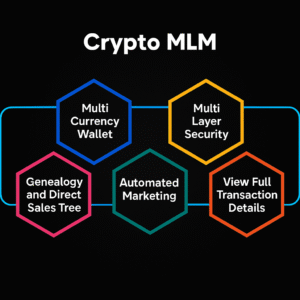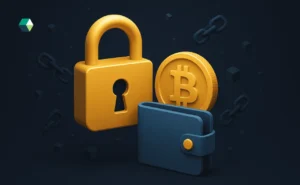
In the rapidly evolving world of Web3, understanding the basics of blockchain public and private keys is essential for anyone interacting with decentralized technologies. These cryptographic keys play a fundamental role in securing transactions, managing digital assets, and ensuring the integrity of Decentralized Applications (dApps). This comprehensive guide will delve into what blockchain public and private keys are, their importance in Web3 wallets, and how they function within the blockchain ecosystem.
What is a Web3 Private Key?
A Web3 private key is a crucial component in the realm of blockchain and Decentralized Applications (dApps). It is a randomly generated string of alphanumeric characters that provides access to the funds and assets associated with a Web3 wallet. This private key acts as a digital signature, allowing the wallet owner to authorize transactions and interact with various blockchain services securely. Unlike a password, which can often be reset or recovered, a private key is unique and irreplaceable. If it is lost or compromised, access to the associated assets is permanently lost. Therefore, safeguarding the private key is of paramount importance for anyone participating in the Web3 ecosystem.
What is a Web3 Public Key?
A Web3 Public Key is an essential part of the cryptographic system used in blockchain technology and decentralized applications (dApps). It is derived from the private key and serves as a publicly accessible identifier for a Web3 Wallet. The public key allows others to encrypt information or verify signatures without exposing the private key. In practical terms, it is used to generate wallet addresses that can receive funds or interact with various blockchain services. While the public key can be freely shared, it is mathematically linked to the private key, which remains confidential. The public key’s primary function is to enable secure communication and transactions in the Web3 environment, ensuring that only the rightful owner, who possesses the corresponding private key, can access or authorize the use of the associated assets.
Where is the Private and Public Key in a Blockchain Wallet?
In a blockchain wallet, the private and public keys are stored securely to facilitate transactions and interactions with decentralized applications (dApps). Here’s a breakdown of where and how these keys are managed:
Private Key Storage
The private key is stored on the user’s device, often encrypted to prevent unauthorized access. This could be on a computer, smartphone, or hardware wallet. Specialized devices like Ledger or Trezor securely store private keys offline, providing robust protection against hacking attempts and malware. These wallets store the private key within the application on your device. They use encryption and other security measures to protect the key. A physical printout of the private key and public address, often in the form of QR codes, kept securely offline. In some cases, third-party services hold the user’s private keys on their behalf, taking responsibility for their security and management.
Public Key Storage
The public key is stored within the wallet software and used to create addresses for receiving funds. When a transaction is made, the public key (or the address derived from it) is recorded on the blockchain, allowing anyone to verify transactions and balances. Users can share their public key or wallet address with others to receive payments or participate in dApps.
What Does a Public and Private Key Look Like in Blockchain?
In the blockchain ecosystem, public and private keys are represented as long alphanumeric strings composed of hexadecimal characters. A public key typically looks like a lengthy string of characters, often starting with “0x” to denote that it’s in hexadecimal format. It might resemble something like 0x6d8e3b4f81e6c0a6c7542db9bfe6a8e6d02d32cf, which is used to generate a wallet address and can be shared openly.
Conversely, a private key is also a long hexadecimal string, but it’s intended to be kept secret and secure. It might appear as 0x4f3a4a6b9e7d82a0b18e3c2a5c1e8f3a23b5c0d0, and it provides the necessary authorization to access and manage the assets associated with the wallet. While the public key is used to receive funds and verify transactions, the private key is required for signing transactions and proving ownership. The security of these keys is crucial, as anyone with access to the private key has control over the associated assets.
How Do Web3 Wallets Use Public and Private Keys?
Web3 wallets rely on public and private keys to manage and secure digital assets on the blockchain. Here’s a simplified explanation of how they work together:
-
Generating Keys
When you create a Web3 Wallet Development, it generates a pair of cryptographic keys: a public key and a private key. This process involves complex algorithms that ensure each key pair is unique.
-
Public Key Usage
The public key is used to generate your wallet address. This address is derived from the public key and is shared with others to receive funds or interact with decentralized applications (dApps). It acts as a public identifier for your wallet on the blockchain.
When someone wants to send you cryptocurrency or other digital assets, they use your wallet address (derived from your public key) to direct the funds. The public key is visible and can be shared without compromising security.
-
Private Key Usage
The private key is used to sign transactions and authorize actions in the blockchain network. When you initiate a transaction, your Web3 wallet uses your private key to create a digital signature, proving that you are the owner of the assets being sent.
The private key must be kept secret and secure, as it provides access to your assets. Anyone with access to your private key can control your funds, which is why safeguarding it is critical.
-
Encryption and Security
The private key is stored securely, often encrypted within the wallet application or hardware wallet. This ensures that even if the wallet is compromised, the private key remains protected.
When you sign a transaction, the blockchain network uses your public key to verify the digital signature created by your private key. This verification process ensures the authenticity and integrity of the transaction.
How to Secure Your Wallet’s Public and Private Keys?
Securing your wallet’s public and private keys is critical to protecting your digital assets from theft and unauthorized access. To ensure robust security, start by keeping your private key confidential and never sharing it with anyone. Use a hardware wallet for added protection, as it stores your private key offline, minimizing exposure to online threats. For software wallets, ensure that your private key is encrypted and backed up securely. Regularly back up your wallet using a recovery phrase and store this backup in a separate, secure location, such as a safe or safety deposit box. Be cautious of phishing attempts and malware by maintaining up-to-date security software and avoiding suspicious links or emails. Additionally, enable two-factor authentication (2FA) where possible to add an extra layer of security to your wallet. By following these practices, you can significantly reduce the risk of losing access to your assets or falling victim to cyber attacks.
How Do I Get Public and Private Keys for a Web3 Wallet?
Obtaining public and private keys for a Web3 wallet is a fundamental step in managing digital assets on the blockchain. Here’s a comprehensive guide to understanding and acquiring these keys:
-
Choosing a Web3 Wallet
Decide on the type of Web3 wallet that best suits your needs. Options include:
- Software Wallets: These are applications that you install on your computer or smartphone. They are convenient for everyday use and come in forms such as desktop applications, mobile apps, and browser extensions.
- Hardware Wallets: These are physical devices that store your private keys offline. They are highly secure and are ideal for safeguarding large amounts of cryptocurrency.
-
Setting Up the Wallet
For software wallets, download the wallet application from a reputable source or the official website. Ensure that you are using the latest version of the wallet software to benefit from the latest security features. For hardware wallets, follow the manufacturer’s instructions for setting up the device, which usually involves connecting it to your computer and installing the corresponding software.
-
Generating the Keys
During the setup process, the wallet will automatically generate a pair of cryptographic keys: a public key and a private key. This process typically involves creating a new wallet or account within the wallet application. The private key is generated randomly and kept secure within the wallet software or hardware device. The public key is derived from the private key using cryptographic algorithms and is used to create your wallet address. Some wallets provide a recovery phrase (also known as a seed phrase) consisting of a series of words. This phrase is a human-readable representation of your private key and can be used to restore access to your wallet if the original key is lost.
-
Accessing Your Public Key
Once your wallet is set up, you can view your public key through the wallet interface. This key is often displayed along with your wallet address, which is a shorter, more user-friendly version of the public key. The public key is used to generate your wallet address, which is what you share with others to receive transactions. This address is derived from the public key and is safe to share openly.
-
Ensuring Key Security
The private key should remain confidential. Anyone who gains access to your private key can control your assets, so it’s essential to keep it secure. Avoid sharing it and be cautious of phishing attempts or scams that might try to obtain your private key. Regularly back up your wallet and recovery phrase. Store these backups in a secure, offline location separate from your primary device. This ensures that you can recover your assets if your device is lost, stolen, or damaged.
-
Securing the Keys
Store your private key and recovery phrase in a secure location. Avoid storing them digitally or online, as this can expose them to hacking or phishing attacks. Consider writing them down and keeping them in a safe place, such as a safety deposit box. For added security, enable two-factor authentication (2FA) and other security features provided by your wallet application. Regularly update your wallet software to ensure you have the latest security patches and improvements.
What makes Nadcab Labs for Public and Private Keys in Web3 Wallets?
Nadcab Labs stands out for its expertise in managing public and private keys for Web3 Wallets through its comprehensive approach to security and user experience. With a focus on cutting-edge technology and best practices, Nadcab Labs ensures the highest level of protection for private keys by utilizing advanced encryption techniques and secure storage solutions. Their solutions integrate seamlessly with various Web3 wallets, providing users with a reliable and user-friendly interface for key management. By prioritizing robust security measures, including multi-layered authentication and regular security audits, Nadcab Labs helps safeguard digital assets against theft and unauthorized access. Their commitment to innovation and excellence makes them a trusted partner for developing and managing secure Web3 wallet solutions.







